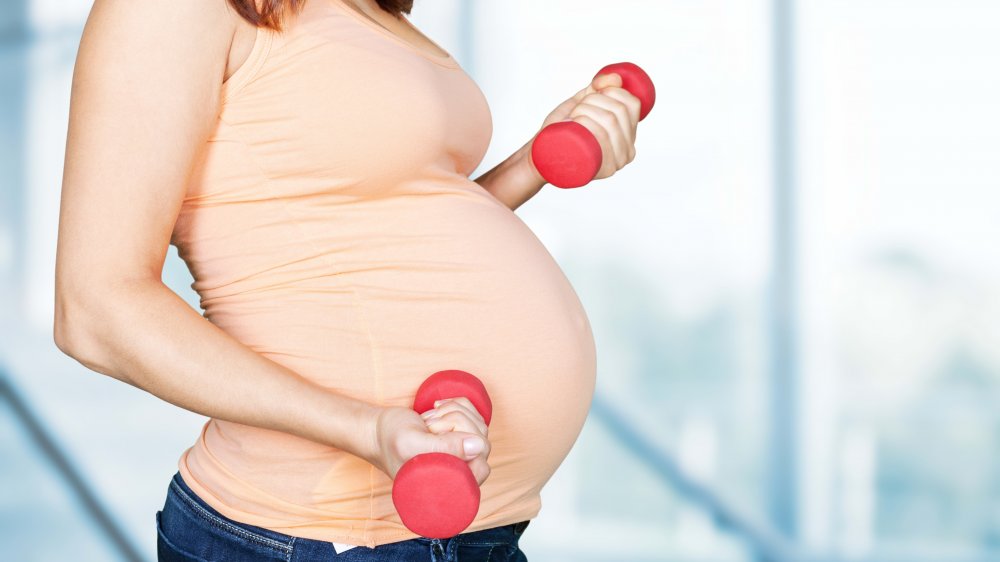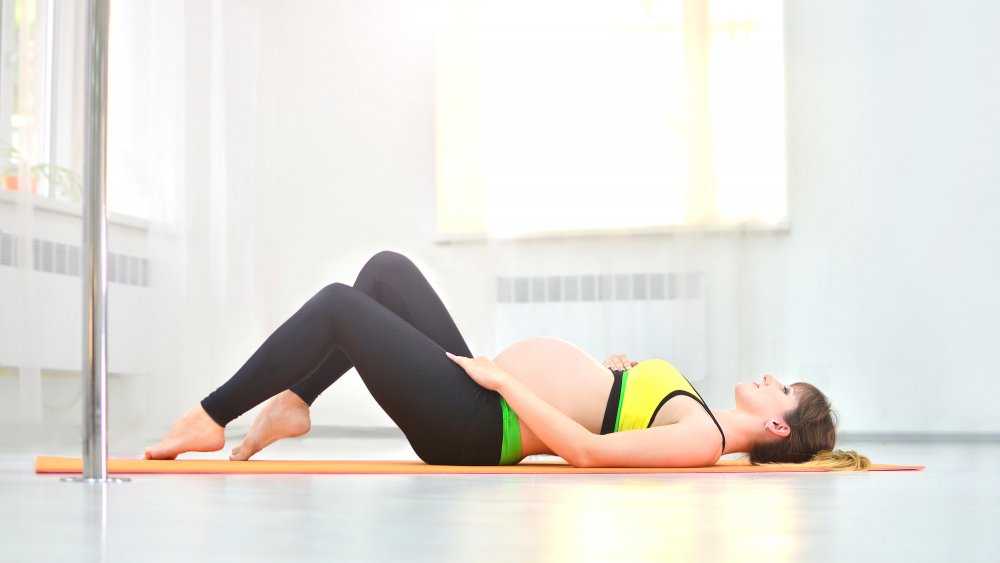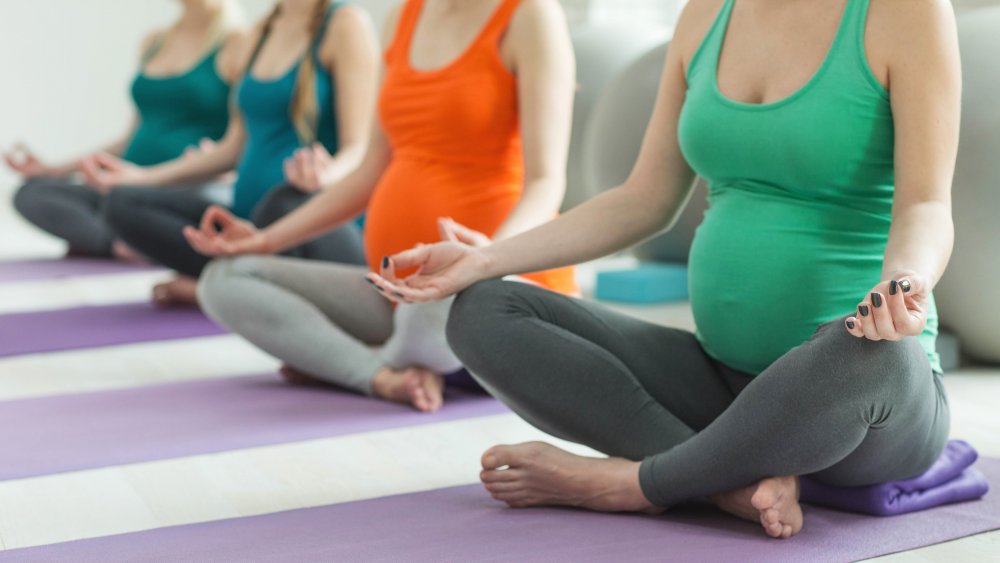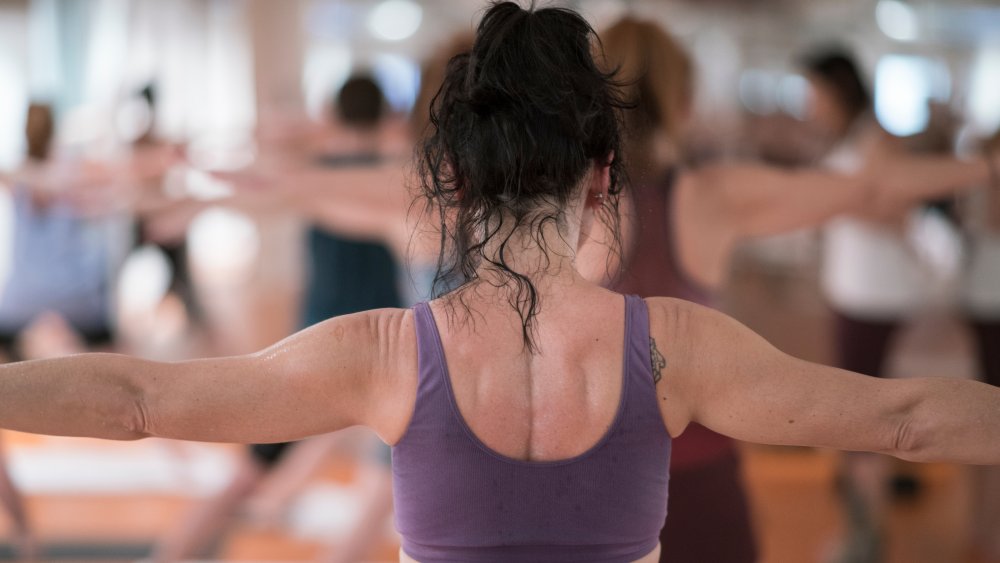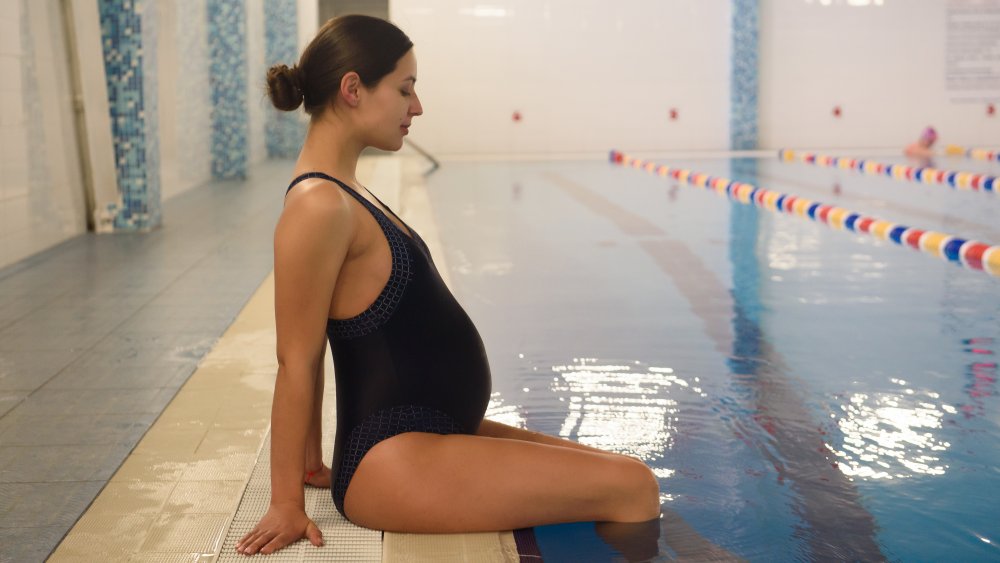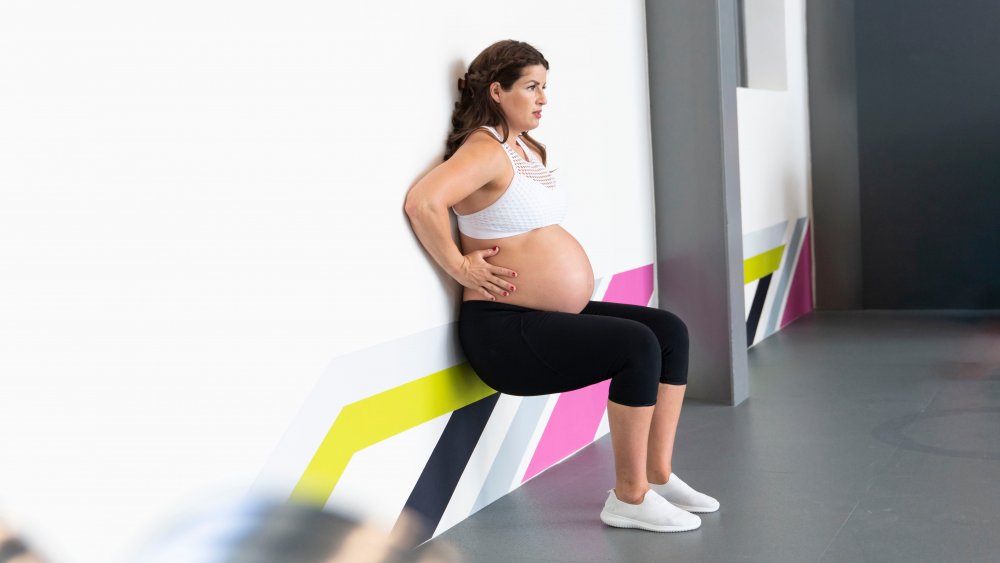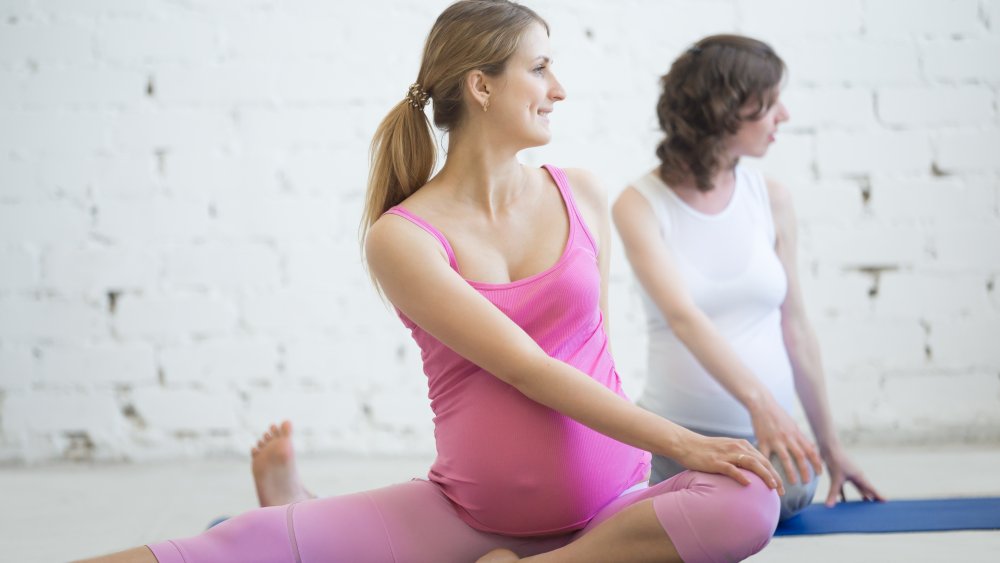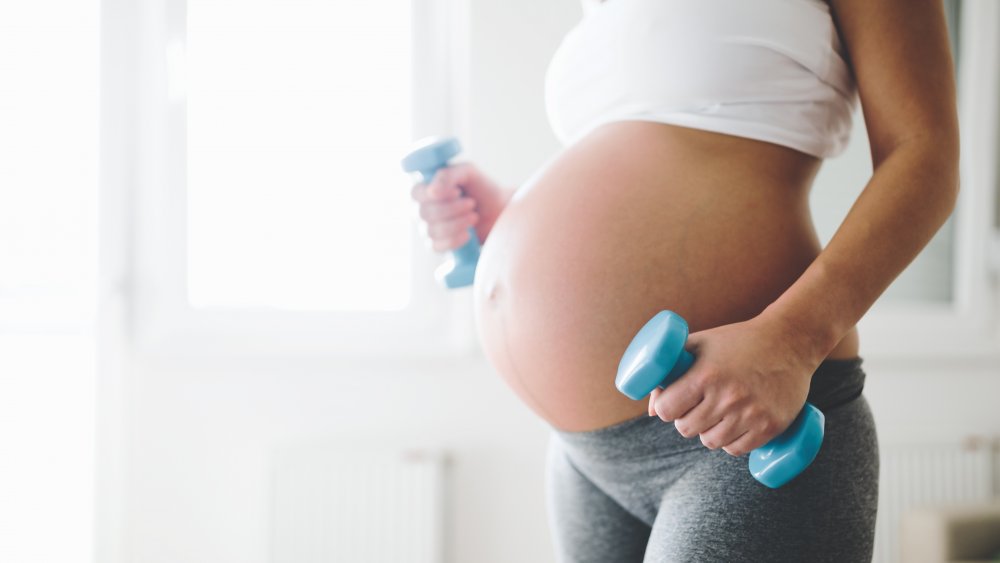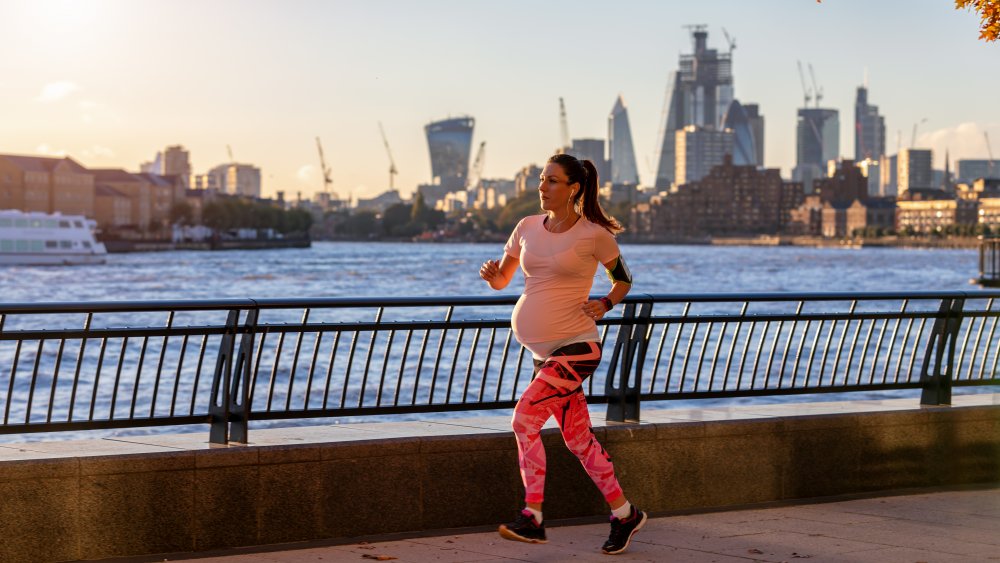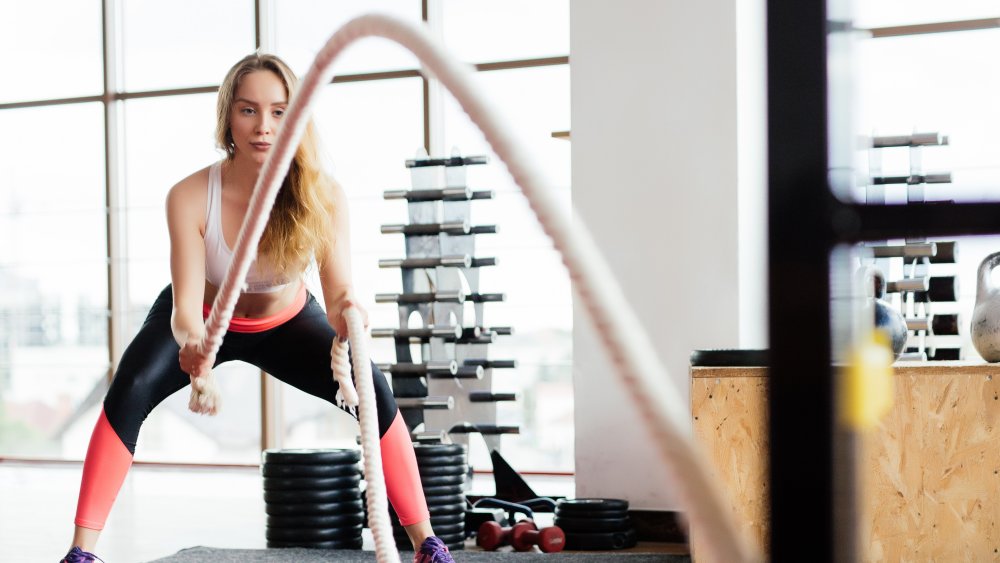7 Exercises To Do While Pregnant And 7 Exercises You Should Avoid
Doctors recommend that pregnant women get 30 minutes of moderate exercise a day, according to the American College of Obstetricians and Gynecologists. But working out while growing a human can prove to a be a challenge for those juggling perpetual exhaustion, morning sickness, and — you know — everyday life.
Fortunately, most women find reprieve from the struggles of early pregnancy when they hit the beginning of the second trimester, as noted by Medical News Today. Yes, relief is on the way, mama — and you could feel an uptick in energy or an end to nausea any day now. This is when exercise becomes a whole lot less daunting.
Of course, just as you get back into the swing of things, your sports bra and leggings stop fitting, and your burgeoning belly gets in the way of all your favorite moves. The struggle is real, but there are lots of reasons to stay physically active despite some difficulties. The American Pregnancy Association notes that prioritizing fitness in pregnancy helps to improve circulation, reduce pain, bolster mood, and prepare the body for labor. But what exercises are you cleared for and which ones should you forgo until after pregnancy? Turns out there's a lot of things pregnant women need to know about fitness. Here are exercises to do while pregnant, as well as exercises to avoid.
Do go on walks while pregnant
Exercise can sound daunting when you're pregnant, but you might just find your stride with an invigorating walk. Plus, since it is completely free and you can start independently at your own pace, walking is a great option for pregnant women of all fitness levels.
What's more, according to Mayo Clinic, walking is an ideal choice as "it provides moderate aerobic conditioning with minimal stress on your joints." Better yet, it helps foster heart health while toning up your muscles, according to Parents. Liz Neporent, author of Fitness Walking for Dummies, told the magazine that exercising during pregnancy can help expecting women in their near future. "A stronger mom will have an easier time meeting the demands of motherhood," Neporent said. She also inferred that walking can be therapeutic since it is "something you can do just for yourself before you have to focus on your baby."
In short, walking is good for the body, mind, and soul, and is a great exercise to do while pregnant. And you might as well get used to it — you are going to be pushing a stroller down the street in no time.
Don't do crunches or other ab workouts while pregnant
Prenatal Pilates teacher Clarissa Smirnov told Self that "crunches are the worst thing possible" if you are pregnant. Smirnov explained that, while engaging the core during the first 13 weeks can feel physically possible without the presence of a big belly, doing exercises like crunches can actually make postpartum recovery a whole lot more difficult. Yes, instead of helping women bounce back faster after child birth, working your abs during pregnancy can have the opposite effect. This is due to diastasis recti, the separating of ab muscles that can potentially happen as your belly grows, according to What to Expect. It is a fairly common postpartum affliction, affecting nearly 50 percent of women.
And while you will want to avoid crunches, sit ups, and other typical six-pack-producing exercises, the experts at What to Expect suggest doing pelvic tilts to "engage your deeper transverse abdominus muscles." In this easy exercise, lay down on your back with knees pointed upwards and your feet on the ground. Simply lift your pelvis off the floor, while pressing your lower back toward the ground. Then slowly release.
Do prenatal yoga to keep your body and mind healthy while pregnant
Namaste in bed? No way, mama. Get up and do some yoga. Bec Conant, a prenatal yoga teacher and doula, told Greatist that yoga's combination of stretching and strengthening exercises makes it a wise exercise to do while pregnant. Furthermore, she noted that practicing yoga during pregnancy can help you honor your changing physique. "It's a physical form of exercise that's also going to bring some mindfulness and awareness into how your body is changing," Conant said.
Additionally, Heidi Kristoffer, founder of CrossFlowX, told Greatist that yoga breathing alone makes it a worthy choice for expecting women. She suggested some specific poses to help relieve the common pains of pregnancy. To help alleviate belly weight, she likes "wide-knee child's pose" and "cat-cow pose." For an achy back, she advised doing simple hip-opening exercises like "ankle-to-knee pose," a seated position similar to sitting cross-legged.
If you are new to yoga, stick with a prenatal-specific practice. Experienced yogis, however, are generally able to keep up with more advanced poses, according to Verywell Fit; however, pregnant women should tell their yoga instructors about their pregnancy and should never perform poses that make them uncomfortable. No matter the experience level you have, you are going to need that zen frame of mind when your baby comes along.
Don't do hot yoga while pregnant
While simple yoga movements and stretches can be beneficial for expecting moms, practicing them in extreme temperatures is certainly not. That is why doctors and experts advise against doing Bikram yoga, or hot yoga, a practice that jacks up the studio heat to a whopping 105 degrees, according to Shape.
A study published in Canadian Family Physician in 2014 noted that, while there are no existing studies that center around the practice of hot yoga during pregnancy, high heat levels could lead to hyperthermia, which is associated with an "increased risk of neural tube defects and possibly of other malformations among fetuses."
Livestrong also argues that excessive sweating could be dangerous to pregnant women as "fluid losses increase your heart rate and decrease blood volume, potentially causing fetal stress." Furthermore, as women experience "joint laxity caused by the hormones" during pregnancy, the intense heat might enable her to stretch too far or push her physical boundaries, potentially causing injury. In short, consider hot yoga one of the exercises to avoid while pregnant.
Do go swimming throughout your pregnancy
Swimming is one of the very best exercises to do while pregnant for various reasons. In addition to giving both your arms and legs a significant workout, BabyCenter notes that it is "low impact and gentle on your body." Furthermore, as indicated by the site, being surrounded by water keeps you cool and comfortable during a workout, and can help you avoid injury. Best of all, the "buoyancy of the water lets you enjoy a feeling of weightlessness despite the extra pounds of pregnancy." In other words, if want to feel light and free, submerge your bump — and whole body, for that matter — in a pool.
In addition to the physical benefits of swimming, there are other perks to this pregnancy activity. The American Pregnancy Association recommends relaxing or gently swimming in a pool to help alleviate edema, or the swelling of extremities during pregnancy. So get on that maternity swimsuit and show off that beautiful big belly.
Don't do traditional leg lifts and other moves that require you to lay on your back while pregnant
Studies, including one published by The Journal of Physiology in 2017, have shown that resting flat on your back for even short periods of time can be dangerous for an expecting mom and her baby. In that precarious position, the uterus puts pressure on the inferior vena cava, potentially causing a dramatic rise in a pregnant woman's blood pressure and/or cutting off blood supply to the fetus. That sums up why you will want to avoid traditional leg lift exercises, where you lay down and raise your legs up and down, in addition to other movements that start from a flat-on-floor position.
Still, that does not mean you have to abandon all your favorite workout moves. BabyCenter suggests propping your upper body slightly with a pillow so that you can comfortably perform some of your favorite exercises without putting pressure on the vena cava. A slight physical modification or the use of certain workout tools — like a wedge or yoga ball — can be the difference in making an ill-advised exercise a smart option for pregnant women.
Do prepare for labor by practicing squats with a yoga ball while pregnant
Squatting "helps open your pelvic outlet," enabling the unborn baby to move down, making it a great go-to move during labor, according to Mayo Clinic. Since practice makes perfect, prepare for the delivery room by doing squats throughout your pregnancy, too. Yes, doing squats is one exercise to do while pregnant.
You can make this move a bit easier with the help of a yoga ball and the support of a wall. Simply, place a yoga ball between your back and the wall. "Slide down the wall until your knees reach a 90-degree angle, being careful to keep your heels flat on the floor," Mayo Clinic advises. 'If you can't bend your knees to a 90-degree angle, simply go as low as you can..." Then get back up, and start all over again. The goal should be to get to a place where you can do about ten of these squats in a row. As per Mayo Clinic's suggestion, you should have a spotter present to prevent falls.
Don't perform twisting exercises while pregnant
If your pregnancy workout has you doing deep twists, quick turns, and mind-boggling backbends, you should probably reevaluate and adjust for the next few months. Twists can "strain the abdominal muscles," according to Bliss Baby Yoga, which are already working hard to make room for your expanding uterus. Twisting can also "limit the baby's space and can restrict blood flow to the uterus." Shari Barkin, a pediatrician, told Yoga Journal that, in the first 13 weeks of gestation, women should avoid "inversions, twists, or jumps" because "it's important not to jar or threaten implantation of the fetus and placenta."
Additionally, your pregnant body experiences a surge in the hormone relaxin, which helps foster free movement and gets the body ready for the work of labor and delivery. But, as noted by Yoga International, expecting women need to ensure they do not overstretch to the point of injury since this hormonal surge makes the ligaments looser and more relaxed.
Do perform light weight training while pregnant
While you certainly should not engage in any intensive body building, you can still get your reps on while expecting. According to The Bump, most women who are used to lifting free weights can resume this activity throughout their respective nine-month journeys, but should "logically decrease the weight as pregnancy progresses to honor and respect their changing body." Furthermore, the experts at Parents suggest opting for weight- and resistance-training machines since they help "control your range of motion." But if you can't make it to the gym, two to five pound dumbbells will also do the trick, and using them is a fine exercise to do while pregnant.
Toning with weights can help sculpt the body and keep you in shape during pregnancy; plus, there could be additional benefits. BabyCenter noted that there have been studies that show "weight training may help women with gestational diabetes manage their condition," potentially eliminating the need for insulin.
Of course, whether you are weight training to stay active or to control your insulin dependence, you will want to listen to your body and take some extra precautions. BabyCenter advises women to carry free weights with care to ensure they don't accidentally hit their belly.
Don't participate in contact sports while pregnant
Football, soccer, ice hockey, and boxing are among the contact sports that women should not play when they are pregnant. The American College of Obstetricians and Gynecologists warns moms-to-be that any physical activity where there is the possibility of trauma or collision, or where their respective stomachs could potentially get hit by a ball, a foot, or an arm, is just too risky.
While this advice may seem obvious, the line is a bit blurred when we are talking about professional athletes. As noted by Sports MD, some pros keep competing despite a growing baby bump, including Olympic gold medal winner and volleyball superstar Kerry Walsh.
Additionally, per Parents, amateur athletes should note that the release of the hormone relaxin during pregnancy loosens up ligaments which could make you less confident on your feet while playing sports, and the change in your center of gravity — with a large belly leading your body — might further affect balance.
Do maintain your pace if you're a regular runner while pregnant
If you're an experienced runner or jogger, there is no reason to stop in your tracks during pregnancy. Still, even if you are a regular marathon racer, you have to listen to your body and do what feels right. According to What to Expect, you might need to slightly alter your pace. "You should be able to carry on a conversation as you stride and breathe into your diaphragm on every single breath," What to Expect noted. "If it's hard to suck in deeply, you may be going too fast or putting pressure on your tummy or pelvic floor."
The online destination for expecting moms also recommends that a pregnant runner should invest in a quality pair of comfortable sneakers, a new sports bra that fully supports her growing assets, and maybe even a maternity belly belt. Furthermore, the site advises that you should "shift your focus from clocking miles to logging minutes, zeroing in on perceived effort and not maximal heart rate."
Don't do any exercise activities where you could fall while pregnant
Got a big trip planned to your favorite ski mountain? You might want to stick to some relaxing activities. Physical sports where you could potentially take a fall — like skiing and snowboarding — are especially risky during pregnancy. While non-pregnant people fall during these activities, too, you're more prone to a spill when you're pregnant with ligament-loosening relaxin coursing through your body. Your center of gravity and sense of balance also completely changes, per the American College of Obstetricians and Gynecologists. So it's best to consider sports like snowboarding as exercises to avoid while pregnant.
Parents warns that these athletic endeavors are extra dangerous after pregnant women hit the 20-week mark because "when the uterus extends past the pelvis, falling on your abdomen could cause premature labor, separation of the placenta from the baby, or a fetal injury." Instead, the magazine suggests ski bunnies try light cross-country skiing or easy snowshoeing.
Do keep up with kegel exercises while pregnant
Want to exercise at your desk, in the car, or while eating dessert? You can practice Kegel movements anytime and anywhere — and nobody will be the wiser. Yes, doing Kegel exercises is one piece of advice you should listen to while pregnant. But how do you actually do it? It's basically the same mechanism you use when "holding in" or suddenly stopping your urine stream.
To clarify, doing Kegels alone isn't going to cut it when it comes to getting in that 30-minute cardio session. But this simple contract-and-release exercise can help to make the muscles of the pelvic floor stronger — which will hopefully set you up for an easier time laboring and delivering a baby, according to the American Pregnancy Association. Plus, giving these muscles a regular workout can help "minimize two common problems during pregnancy: decreased bladder control and hemorrhoids." Keeping up with Kegels before welcoming a baby can set you up for a smoother recovery process, according to WebMD. That is because Kegels "promote the healing of perineal tissue," encourage those aforementioned pelvic floor muscles to "return to a healthy state, and increase urinary control."
Don't do CrossFit or other high-impact workouts while pregnant
High-impact workouts are ones defined by getting "both feet ... off the ground at the same time," according to Verywell Fit. Of course, while those who are more experienced with this type of physical training may be able to continue their rigorous routines well into pregnancy pending doctor approval, most expecting women should try to tone down the intensity and stick to low-impact exercises, such as yoga, swimming, elliptical training, stationary bike riding, and walking. What to Expect notes that the American College of Obstetricians and Gynecologists advises against many motions common in CrossFit, interval training, and high-impact workouts, "including jumping, jarring motions or quick changes in direction." These are all exercises to avoid while pregnant.
Want to try a safer exercise that can get both feet off the ground? Get out a good old-fashioned jumprope. Dr. Iffath Hoskins, an obstetrician-gynecologist in New York City, told The Bump that "jumping rope is a good form of cardio and helps create good balance and flexibility of the muscles and joints." She advises you wait until the second trimester to take up this activity, and "start with a running motion (one foot in front of other while using the rope) as it will cause less jarring; it's more like jogging but with a rope."
